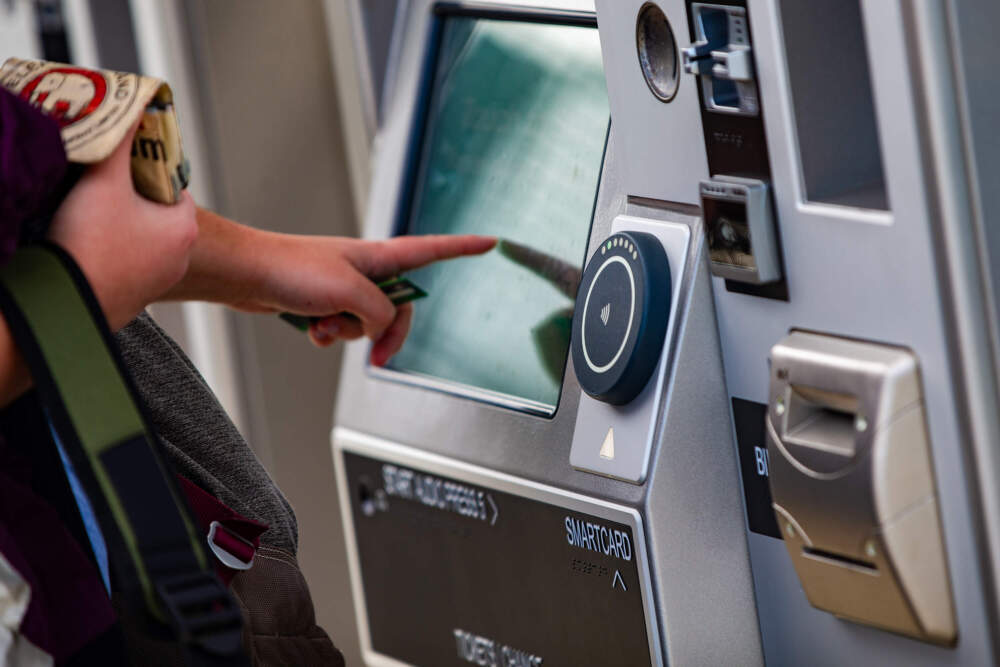Stationed by the ticketing kiosks on the MBTA’s Ball Sq. station in Medford on a latest afternoon, two members of the T’s new “fare engagement” group had been prepared intercept riders.
Massimo Ricci greeted an approaching rider, and confirmed him find out how to faucet his CharlieCard to verify he paid.
“Thanks, sir,” he mentioned, handing him a receipt. “If anyone asks you to point out that, you may be all set.”
Ricci is a part of a brand new crew of MBTA employees who may be discovered at stations alongside the Inexperienced Line Extension. They’re a part of the transit system’s not too long ago established Fare Engagement Division.
Merely put: The T actually needs extra individuals to pay their fares after they journey.
Name it a mushy begin. For now, the T says the aim is to assist riders navigate the transit system. However it’s additionally a introduction to the thought somebody will quickly be checking that riders have paid their fare, mentioned the T’s chief of coverage and strategic planning, Lynsey Heffernan.
“In some unspecified time in the future in time, these people will even begin to examine fee,” she mentioned.
The brand new group is a part of the T’s technique to maximise fare assortment on the Inexperienced Line and finally on buses, too. Heffernan mentioned the T wants riders to “be certain that they know find out how to pay and likewise perceive why it is essential for the MBTA.”
The T counts on fares to assist its working finances. A number of years in the past, 31% of the system’s working funds got here from rider fares. This yr, fares will solely contribute 15%, partly as a result of drop in ridership because the pandemic.
For an company going through an estimated $700 million finances deficit subsequent yr, gathering each greenback is crucial.
The issue of individuals using free of charge is just not new. And it isn’t distinctive to the MBTA; transit authorities throughout the nation are grappling with find out how to curb fare evasion. New York’s Metropolitan Transit Authority estimates it misplaced $644 million in uncollected fares on its subway, bus and railroad modes in 2022.
The T says it doesn’t have post-pandemic fare evasion knowledge, however the authority estimates it misplaced about $6 million a yr to free rides on its subway and bus traces earlier than the pandemic and between $10 and $20 million a yr on the commuter rail.

Stations that don’t have fare gates, like street-level Inexperienced Line stops, are notably susceptible to fare evasion. Allston resident and Inexperienced Line rider Fita Refinalia mentioned she typically sees individuals keep away from paying after they hop on to journey only a cease or two.
“Possibly they really feel prefer to pay the identical quantity for the lengthy distance and quick distance, it is probably not justified to pay,” she mentioned.
For Inexperienced Line conductors, making an attempt to police fare-paying is an added burden — and the brand new contactless fee system T rolled out this summer time hasn’t helped.
The know-how makes all-door boarding doable, and may enhance effectivity, however makes it harder to make sure riders truly faucet to pay. Actually, the T estimated it might lose at the least $25 million {dollars} extra per yr except it may put a group on the bottom to verify individuals are paying.
In public feedback final month, MBTA Common Supervisor Phil Eng mentioned he’s “not giving up” on gathering fares. “That is an essential space and I am happy to say that the fare engagement employees that we now have employed are making a distinction.”
Eng mentioned fare assortment has improved by 35% on the Inexperienced Line Extension within the few weeks since dispatching the brand new group. “And that is not even enforcement, that is simply schooling of speaking in regards to the contactless fee, and simply speaking in regards to the significance of fee,” he mentioned.
T officers count on that by the spring, these representatives will spot examine that riders paid their fare, very similar to what occurs in some European programs.
“Because the know-how continues to develop, they’re going to be in a spot the place they’re going to have some handheld units and may guarantee that riders have paid,” Heffernan mentioned.
Riders who don’t pay may get citations starting from $50 to $100.
This section aired on November 12, 2024.

